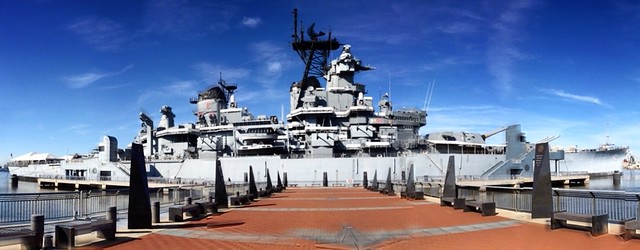It was an interesting weekend for us; there was a lot going on. Both Riley and Abby had sports events. On Saturday Riley had a baseball game at Hickory Park and Abby had a soccer game at Fellowship Fields (at which I was "coaching"). Shortly after Abby's game, Riley and I left for Camden to camp on the battleship New Jersey with a group from Pack 32.
Visiting the USS New Jersey was definitely a unique experience. The boys from Riley's cub scout pack (and their dads) got to experience a lot of the ship. The evening tour after mess was pretty exclusive, too. We got to tour areas of the ship that you don't get to see on a normal walking tour, like the areas inside the gun turrets where the ammunition is prepared and sent to the firing stations. The tour guide was very knowledgeable, and thankfully very patient with our precocious boys.
We learned a lot of interesting factoids about the New Jersey. The whole ship is made primarily of steel, which is pretty obvious if you think about it. But the amount of steel used is astonishing. Some of the armored doors and walls on the ship are made of solid steel 17 inches thick.
Just one of the three primary turrets weighs the same as a destroyer from the same era as the New Jersey. That's like having three destroyers on board the ship! Each gun in the turret fires a huge shell, propelled by 600 pounds of gun powder. If fired straight up, the shell would reach 17 miles high.
There are "smaller" 5-inch caliber guns on the sides of the ship. The shells for this gun are stored in the lower decks and raised to those turrets with constantly-moving chain elevators. These shells are primarily used to shoot down enemy aircraft. The nose of each shell contains a small vacuum tube that detects when the shell gets near metal, kind of like a poor-man's radar. When the shell is near metal, like the hull of an enemy aircraft, the shell detonates. This function of the US 5-inch shell was a closely guarded secret throughout World War 2, and wasn't even shared with our allies. The shells were never fired over land for fear that one would land, unexploded, on the ground where the Nazis could recover and study it. It is amazing to me that the Axis did not have similar technology, seemingly having all of their shells detonate based on timed fuses.
The New Jersey was in service from 1943 through until the early 90's. It had been retrofitted with modern weapons from the time. There were Gatling guns mounted in several places on the sides of the ship for shooting down incoming missiles. There were Tomahawk missile mounts on the ship for firing these very advanced weapons. There were even rumors that the New Jersey had nuclear capabilities, but the Navy won't confirm whether this was the case.
One of the most interesting rooms on the ship was the CEC, the Combat Engagement Center. This is where all of the on-board weapon systems were controlled. The room is the same eerie blue with all kinds of radar screens that you see in movies. The kids had a lot of fun sitting at the consoles and firing missiles at their enemies.
I had always thought that the doors on a ship were round because of some reason related to water. Of course, our tour guide said that if water was high enough to be a bother to a door, there were much bigger problems to worry about than the shape of the portal. No, the door is round because it is structurally more sound. If a door was rectangular, then when the ship's body has torque - either from weapon impact or heavy seas - then the steel would tear from the corners of the door. Instead, a round door keeps the ship's body intact under pressure.
We learned how to navigate the ship using signs about the compartment locations. We toured the captain's quarters, the admiral's quarters, the mess hall, the officer's mess, medical (including an unusually large dental area), and the bridge. We were able to see inside the turrets at the top, where the guns were aimed and the ammunition was loaded into the barrels.
This was an overnight trip, so we all had to sleep in bunks on board. The bunks were stacked three beds high, and were claustrophobically small. Riley and I took bottom beds in separate bunks because that's all that was left by the time we arrived. Still, the experience was authentic. At lights-out the lights didn't go out, but instead dimmed to an eerie red color. All through the night, you could hear the sound of people banging themselves against the steel bunks trying to get comfortable.
The only thing that was a little disappointing was the food. We usually get such great (too great, sometimes) meals when we camp with the scouts that the chicken finger dinner and hashbrown breakfast were a little small and disappointing. But a meal is a meal, and we got to experience the chow line first hand, which is interesting in itself.
There was a lot more that we saw and did on the ship, and I'm sure even then that we didn't get to see everything since the ship was so huge. In all, the trip was pretty great. Riley had a great time, as he usually does on scouting trips. I'm not sure I'd sleep over again - not wanting to subject myself to the steel coffin bunk and ensuing back pains in the morning - but I'd definitely visit again, perhaps to join a different tour and see other parts of the ship that we missed.
